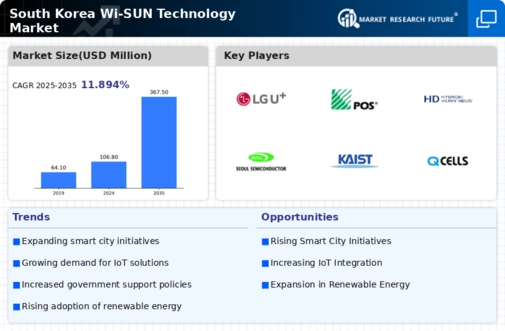The wi sun-technology market is currently characterized by a dynamic competitive landscape, driven by the increasing demand for low-power, wide-area network solutions. Key players are actively pursuing strategies that emphasize innovation, regional expansion, and strategic partnerships to enhance their market positioning. Companies such as Silicon Labs (US), NXP Semiconductors (NL), and Texas Instruments (US) are at the forefront, leveraging their technological expertise to develop advanced solutions tailored for smart city applications and IoT connectivity. Their collective focus on enhancing product offerings and expanding into emerging markets shapes a competitive environment that is both collaborative and competitive.
In terms of business tactics, companies are increasingly localizing manufacturing and optimizing supply chains to enhance operational efficiency. The market structure appears moderately fragmented, with several key players holding substantial market shares while also facing competition from smaller, innovative firms. This fragmentation allows for a diverse range of solutions, catering to various customer needs and preferences, thereby fostering a competitive atmosphere that encourages continuous improvement and innovation.
In October 2025, NXP Semiconductors (NL) announced a strategic partnership with a leading telecommunications provider to enhance its wi sun-technology offerings. This collaboration aims to integrate advanced connectivity solutions into smart grid applications, thereby expanding NXP's footprint in the energy sector. The strategic importance of this partnership lies in its potential to drive innovation in energy management systems, positioning NXP as a key player in the growing market for sustainable energy solutions.
In September 2025, Silicon Labs (US) launched a new line of wi sun-enabled microcontrollers designed specifically for smart metering applications. This product introduction is significant as it addresses the increasing demand for efficient energy monitoring solutions. By focusing on smart metering, Silicon Labs is likely to capture a larger share of the market, reinforcing its commitment to innovation and customer-centric product development.
In August 2025, Texas Instruments (US) expanded its wi sun-technology portfolio by acquiring a smaller firm specializing in low-power wireless communication. This acquisition is indicative of Texas Instruments' strategy to bolster its technological capabilities and enhance its competitive edge. By integrating the acquired firm's expertise, Texas Instruments may improve its product offerings and accelerate time-to-market for new solutions.
As of November 2025, current competitive trends in the wi sun-technology market are heavily influenced by digitalization, sustainability, and the integration of AI technologies. Strategic alliances are increasingly shaping the landscape, enabling companies to pool resources and expertise to drive innovation. Looking ahead, competitive differentiation is expected to evolve, with a notable shift from price-based competition towards a focus on technological innovation, reliability in supply chains, and sustainable practices. This transition underscores the importance of adaptability and forward-thinking strategies in maintaining a competitive advantage.

















Leave a Comment